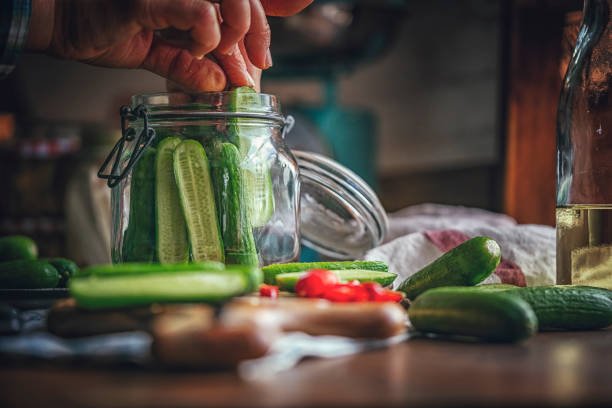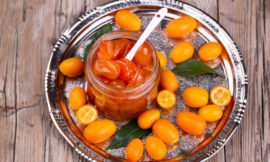HOW TO SAFELY USE HOMEMADE VINEGAR IN PICKLING.
You may have heard somewhere else that using homemade vinegar in the pickling process is not a good idea. That is not completely accurate. It is dangerous to use vinegar that has an acetic acid content that is lower than 4.5 percent (or to dilute the vinegar with more water than the recipe calls for). Therefore, there is no reason not to use your homemade vinegar provided you are aware of its pH and it has an acidic level that is sufficient for your needs.
- One may determine the amount of acetic acid present in homemade vinegar by using a device known as an acid titration kit, which is sold by businesses that specialize in supplying materials for winemaking (see Useful Resources).
- The instructions that come with the equipment on how to test the acidity of wine are somewhat different from the technique that is used to determine the presence of acetic acid. The procedure is as follows: (all of the tools and solutions come with the kit).
- Using the syringe with a capacity of 20 milliliters that is included in the kit, measure out 2 milliliters of homemade vinegar and then transfer it to the testing cup.
- Pour 20 milliliters of water into the container, then add three drops of the indicator solution. Give everything a good stir.
- Pour 10 milliliters of the standard base solution into the syringe until it is full. One milliliter at a time, add it to the mixture that is in the testing cup. Mix well after each of the additions. At first, the solution will be transparent, but after some time it will become a deep rose color. When this occurs, you must refrain from adding a standard base.
- Take a look at the syringe that originally contained 10 milliliters of the standard base, and make a mental note of how much of it you have used. For example, if there are just 2 milliliters remaining, this indicates that 8 milliliters were utilized.
- Determine how many milliliters of standard base you added, then multiply that quantity by 0.6. The number that emerges is the proportion of acetic acid present in the vinegar that you manufactured at home. Multiplying 8 by 0.6 to obtain 4.8 is what you would get if, for instance, you used 8 milliliters of the standard base. Pickling may be done using vinegar that contains no more than 4.8 percent acetic acid.
Take note that the proportion of acetic acid that is being tested here is not the pH but rather the percentage. Because a larger amount of acetic acid indicates that the vinegar is more acidic, this might lead to some confusion. When it comes to evaluating pH, however, lower readings indicate increased acidity.
Apple Scrap Vinegar
PREP TIME: 5 minutes FERMENTATION TIME: 1-week YIELD: 1 pint
Preserve the apple cores whenever you prepare apple sauce, pie, or any other dish that calls for apples (also save the apple peels if the apples were produced organically).
Put them to work in this really simple process of producing vinegar. You may make use of your freezer to store apple leftovers till you have a sufficient quantity.
INGREDIENTS
- 2–3 tablespoons sugar
- 2–3 cups of water that has been filtered and is not chlorine
- Cores and skins of one pound of apples (peels only if from organically grown apples)
INSTRUCTIONS
For each cup of water, use one level spoonful of sugar. The sugar should be dissolved in the water. Because chlorine has the potential to inhibit the fermentation process, which is necessary for the production of vinegar, it is essential to use water that has been filtered or that has not been treated with chlorine.
Place the apple scraps in a bowl, saucepan, or crock that is made of ceramic, glass, or stainless steel, and then pour the sugar water over the top of them. Make sure that the apples are completely submerged in the liquid, but don’t worry if any of them float to the surface.
Place in an open container, cover with a clean dish towel and let to rest at room temperature for one week.
At the very least once every day, give the components a good vigorous mix (more is better). When you mix the liquid once the fermentation process has begun, it will begin to foam.
After one week of steeping and stirring, the liquid ought to have begun to acquire a deeper hue. Remove the fruit by straining it.
For the next two weeks to one month, the liquid should be kept at room temperature and stirred once or more each day. It will first smell mildly alcoholic, and then it will take on a vinegary and sour aroma. oxygen is necessary for the bacterial fermentation process that turns alcohol into vinegar.
During this stage of the procedure, it is essential to avoid covering the liquid with anything that might prevent air from circulating around it. (Just so you know, all vinegar starts out as alcohol;
the bacteria that form vinegar use it as a food source.) 6. When the vinegar has reached the level of intensity that you find satisfactory, pour it into bottles and seal them with corks or screw-on caps.
It is OK to use vinegar in salad dressings, marinades, and sauces if you find that it enhances the flavor of the dish. But in order to safely use homemade vinegar for pickling and canning, it has to contain at least 4.5 percent acetic acid, exactly like commercial brands of vinegar do. This is a requirement that must be met.
Sweet Red Pepper And Cucumber Relish
Naturally Pink Cauliflower Pickles






